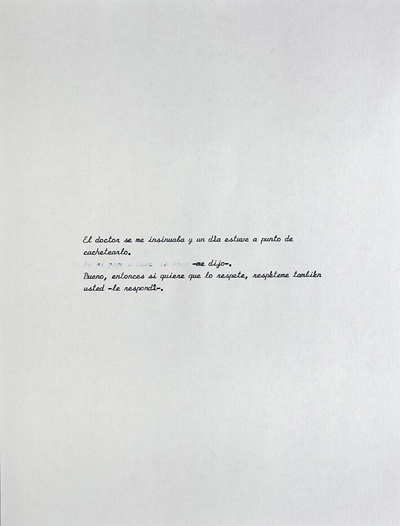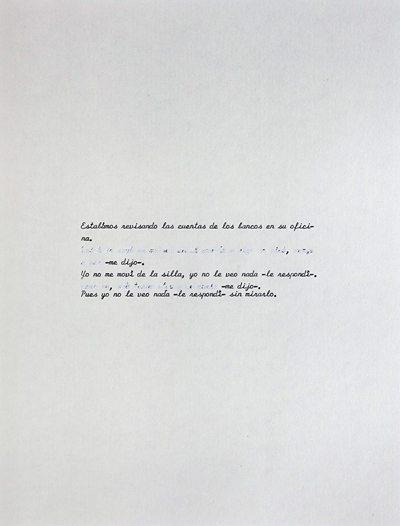Abigail Reyes
Colette Copeland
April 2021
 Abigail Reyes, Liliana Bloch Gallery, Dallas, Texas, February 13 – March 13, 2021.
Abigail Reyes, Liliana Bloch Gallery, Dallas, Texas, February 13 – March 13, 2021.
Yes sir
Yezzir
Yezur
Yes sir, I’d like another
Yes means yes
Yes, indeed
Yes Bossman
Yes I will
Yes Sir Boss
Sir
Sire
Unde-Sir-ed
Sir-rah
Yes please
Indubitably
Affirmative
Certainly
My thoughts exactly (not exactly) (not at all)
As you wish
I hear and obey (for what is the alternative)
I shall
I will
What can I do for you your excellency?
Your Reverence
My-lord
My dear sir
Word play by Colette Copeland
San Salvadoran artist Abigail Reyes’ first U.S. solo exhibition at the Liliana Bloch Gallery, Aquí se come carne (Here we eat meat) sources popular television and real-life stories to reveal misogynist male behavior prevalent in Latin American culture. Text is a dominant visual strategy in her work. She emphasizes how language has been systemically used to control women. Her work is particularly salient in the wake of the U.S. #metoo movement.
The video Si Señor (2015-2016) is a montaged series of short clips from daytime telenovelas of female actors (office workers) saying “Si Señor.” Two seemingly innocuous words pregnant with meaning–filled with power, subservience, fear and bitterness. Telenovelas like U.S. soap operas are known for stereotypical depictions of characters with hyperbolic drama and plot twists for entertainment. Yet the male actors require only two words to assert their control. The repetition of si senor becomes an absurdist mantra, deconstructing the meaning as well as reducing the capacity for dominance.
The exhibition title is also the title of a large wall text work that confronts the viewer upon entering the gallery. I confirmed with the gallery owner that the reference to women as meat translates between Spanish and English. The woman as object to be consumed/controlled by men is not a new metaphor. The daunting scale of the text would be humorous, if not for its inherent truth.
A second video entitled Ser Secretaria features montaged clips from telenovelas. In one clip, one male tasks another with finding him the “perfect” secretary and lists the qualities required, which include age, appearance and conduct. Like Si Señor, the work emphasizes the machismo pride in the governance over another. It is interesting that the word secretary is derived from the word secret. Secrets that “we” (i.e. women) hold grudgingly in our bodies and minds with our experiences of inequality and injustice.
A simple, but profound text piece, Testimonio is my favorite work in the exhibition. Typed on a type writer, the texts recount experiences of chauvinism and harassment. What is the difference between chorizo and sausage? Come and look at my neck, maybe an animal bit me. Like the exhibition title, the stories would be funny if they weren’t true. I found myself scoffing at the audacious and ludicrous attempts of men in the work place.
Reyes’ work reclaims language that has been used to subvert. Through this reclamation, the original meaning in the words lose their power to oppress. In another body of work by Reyes entitled Poesia popular, she stencils phrases on city walls that incorporate gender and sexual connotations. Yo No Soy Tu Juguete (also a title of a popular song) translates to I am not your toy, which seems an apt response to the male patriarchy.
Testimonio 2
El doctor se me insinuaba y un día estuve a punto de cachetearlo.
No me vaya a tocar la cara -me dijo-. Bueno, entonces si quiere que lo respete, respéteme también usted -le respondí-.
The Doctor harassed me and one day
I was about to slap him.
Don’t you dare to touch my face -he said-. Well, if you want me to respect you, Respect me as well – I replied-.
Testimonio 4
Estábamos revisando las cuentas de los bancos
en su oficina.
Quizá me cayó un animal en el cuello o algo me picó, venga a ver -me dijo-.
Yo no me moví de la silla, yo no le veo nada -le respondí-. Como no, acá tengo algo y me duele -me dijo-.
Pues yo no le veo nada -le respondí- sin mirarlo.
We were reviewing his bank accounts
In his office.
Maybe an animal fell on my neck or something bit me, Come and look – he said-.
I didn’t move from my chair; I don’t see anything – I replied-. Yes, I have something here and it hurts -he said-.
Well, I don’t see anything – I replied- without looking at him.
Abigail Reyes was born in 1984 in San Salvador, El Salvador. Her work has been exhibited extensively for the past 10 years in solo and group exhibitions around the world. She lives and works in La Libertad, El Salvador.
◊
Inspired by Dada, and Situationist Theater, Colette Copeland is a multi-media visual artist whose work examines issues surrounding gender, death and contemporary culture. Sourcing personal narratives and popular media, she utilizes video, photography, performance and sculptural installation to question societal roles and the pervasive influence of media, and technology on our communal enculturation. Her videos employ experimental narrative techniques, and absurdist humor to explore the landscape of human relationships. Currently she teaches art and digital media at University of Texas, and Collin Colleges in Dallas, Texas. website →
For more interviews & articles by Colette Copeland on Arteidolia →



